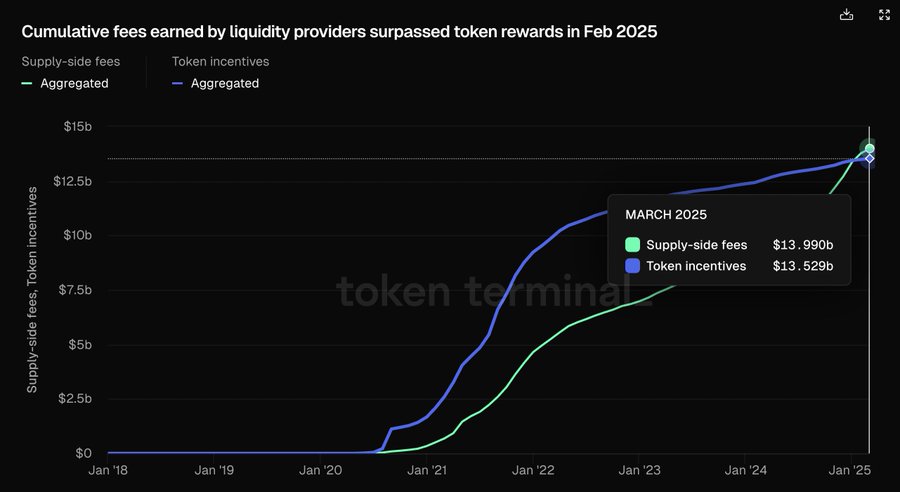DeFi’s Fee Revolution

- DeFi is evolving! Instead of relying on token giveaways, it’s moving towards earning rewards from fees, which is better for long-term health and stability.
- This shift to earning from fees is a big sign that DeFi is growing up. It’s attracting serious investors and institutions who are looking for lasting value.
Decentralized finance, or DeFi, is changing fast, especially when it comes to how liquidity providers are rewarded. For a long time, the big attraction for providing liquidity was getting tokens as incentives. But things are changing, and it looks like DeFi is heading towards a more solid and reliable way of doing things.
These days, liquidity providers are actually making more money from the fees generated by the protocols themselves than from those bonus tokens they used to get. This is a really positive sign for DeFi. It suggests we’re entering a new era where stability and growth for the long haul are becoming the main focus, rather than just quick, short-term gains.
As DeFi matures, this switch could really reshape how the whole decentralized finance world works. It could build a stronger, more resilient system overall.
How DeFi used to work: The old model
Back in the early days of DeFi, platforms needed to get things going quickly, so they offered token incentives. Think airdrops, governance tokens, and yield farming – these were the tools to attract liquidity fast. It worked! Platforms like Uniswap, Sushiswap, and Compound really took off.
But this approach had a downside: it wasn’t sustainable in the long run. As soon as the incentives dried up, or if the price of the tokens dropped, liquidity providers would just move their funds elsewhere. This “farm-and-dump” behavior became common. While it was good for getting things started, it raised serious questions about whether DeFi could be truly stable and reliably liquid over time.
The move to earning from fees
Now, we’re seeing a real change in DeFi. Liquidity providers are starting to earn their rewards from the fees generated by the DeFi platforms, rather than just relying on token handouts.

Source: X
Recent data actually shows that the total fees earned by liquidity providers overtook token rewards way back in February 2025. By March 2025, these fees had climbed to $13.99 billion, while token incentives were at $13.53 billion. This is a pretty big turnaround from how things used to be!
Now, DeFi platforms are increasingly making money through things like transaction fees, staking rewards, and yield farming that’s actually driven by real activity on the protocol. This shift means DeFi protocols are starting to become self-sufficient, generating their own revenue rather than depending on temporary outside rewards.
Why this shift is a sign of DeFi growing up
When DeFi platforms rely more on transaction fees, staking rewards, and yield farming, it makes the whole system more solid and dependable. Unlike token incentives that can be all over the place, fee-based earnings offer a more consistent source of returns. This change really signals that DeFi is maturing, proving it can handle the ups and downs of the market and offer reliable returns to those providing liquidity.
Platforms that have strong fee structures are attracting people who are in it for the long haul. This reduces all that risky, speculative “farm-and-dump” behavior. And as these protocols build sustainable ways to generate revenue, they become much more appealing to big institutional investors who are looking for predictable returns.











